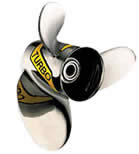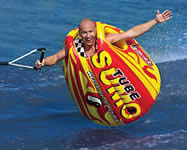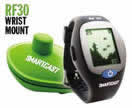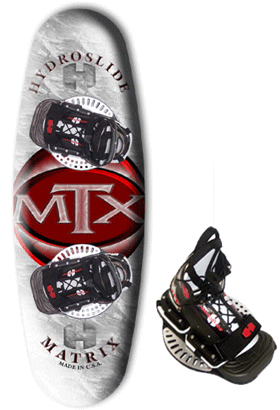Scroll down or click a link below to learn about each topic:
Choosing the Right Propeller
To some, choosing the right boat propeller can seem like a job for a marine service center. Anything that has to do with the backend of the boat can be a scary thing. Despite popular belief, choosing the correct propeller for a particular boat and motor is actually a fairly simple thing to do, once you understand what a propeller really is.
First think of propeller as a gear, whether it be on a car or even a bicycle. The lower the gear, faster hole shot, more power, but revolutions are much faster so at a point you can only turn that gear so fast until you over rev the engine (or you legs). Now think of your car stuck in only 5th or 6th gear, very slow out of the hole, little torque, but eventually it will catch up with itself so you can cruise to a good speed.
The same basic concept applies to propellers, except with a prop you are committed to only one ?gear". So what to do now? Find the prop size that will give the best overall performance. Sound difficult? It's really not.
Your engine has a recommended wide open throttle rpm range. Let take an example of an18' boat with a 125 hp engine with a rpm range of 4500-5500. In most cases you purchase a boat with some sort of propeller on it. Let's say this motor has a 21 pitch prop on it and at wide open throttle under a normal boat load, the engine turns 4900 rpms. Well it's in the range so it's the correct prop, right? Well yes and no. For the health and longevity of the engine it's okay, but for overall performance, you want to run a propeller near the top of the range. Well how do you change the size to get that?
Remember this rule of thumb: For every 2" of propeller pitch, rpm's will change approximately 400 rpm's. As you drop in pitch, rpm's increase, and as you go up in pitch, rpm's decrease. So if we want to raise our rpm's we should choose a lower pitch prop. Following the rule, going down to a 19 pitch should raise our rpm's to about 5300. That would help the hole shot and also gain us some more speed.
As you follow the rule of thumb, remember that sometimes rules are meant to be broken. This is not an iron clad rule, sometimes varying 2" of pitch will only change rpm's by 200. Switching prop brands or manufacturer, it can sometimes throw off the rule too.
At this point the most important thing to understand is that less pitch means more rpm's, more pitch means less rpms. For your boat to perform at its peak, you need to run at the upper end of your engine's recommended rpm range. That's it. Once you're there and still want more speed, handling, lift, etc, that's when choosing the right propeller brand comes into play.
Here's a simple adjustment you can make to improvement performance under varying boatloads: If you normally run with one other person on board, use that boatload as your measurement when determining your wide open throttle rpm's. But if you sometimes load the boat with 2-5 more people or try pulling a water skier or tube, get another prop 2" of pitch lower than your normal prop. It will compensate for added weight and drag and make a huge improvement on performance in these circumstances. But remember to keep an eye on you rpm's when running a lower pitch for these circumstances.
Most props have the size marked somewhere on the prop, either on the barrel, on the blades, or in the front or back of the propeller. Use that pitch that you're currently running as your starting point. If it's already running correctly then that pitch is your pitch.
(back to top)
Hub Systems
Most propeller brands now require propellers to use a transferable/removable hub system that you can do yourself. This means once you buy a propeller and hub system combination you can buy just a replacement prop or different pitch prop with out the hub, at a lower cost. That saves you money. That is the whole idea for these hub systems .There are different props and hubs made for different engine brands and engine sizes.
(back to top)
Aluminum vs. Stainless Steel
The decision between purchasing an aluminum or stainless steel propeller can be difficult. However if you fully understand the differences between them, your decision can be much easier.
The most common understanding of the difference is that stainless steel propellers perform better than aluminum propellers. This is only half true. Material (Stainless vs Aluminum) only accounts for approximately 10% of the actual performance of the propeller. The other 90% of performance is in the blade design.
Well designed aluminum propellers will out perform an average stainless steel propeller. So it's important to research a propeller's performance before your purchase. It is also important to try different pitches and brands to get your boat dialed in to the best possible propeller.
The advantage of a stainless steel propeller over aluminum is durability. Stainless props can withstand more of the damage caused by small rocks, sand, or other loose objects in the water.
However, the disadvantage to a stainless propeller is that there is ?minimal give" to the blades, so if you hit an object hard enough, there is a possibility of causing major damage to your lower unit is increased greatly. With aluminum props, the blades will most likely sacrifice themselves before any damage is caused to your lower unit.
If you run in deep or familiar waters, or in salt/brackish water, a stainless steel propeller can be a good choice. But it is important to always carry a spare propeller on board, and a spare aluminum is an inexpensive choice.
(back to top)
Three blade and four blade propellers
Three blade props are generally the all purpose propeller of choice. They will get your boat up on plane well with good pulling power and give a faster top speed than a four blade propeller.
Four blade propellers are made basically for a little quicker time to plane, more power for towing tubers and skiers, less cavitation problems in tight turns and they work well on larger boats that are slow to plane. Their top end speed is a little slower than a three blade prop and they cost more.
Both three and four blade props are available in aluminum and stainless steel.
For mid-size and larger engines only.
(back to top)
Why not run a damaged propeller?
Continuing to use a damaged propeller can cause damage to the gearcase and ultimately the power head of your motor. When a propeller has sustained damage, it will not spin true, thus creating excessive vibrations that will transfer all the way into your motor.
A damaged propeller will also not perform as well as a new propeller because the damaged parts of the blade can degrade hydrodynamic efficiency.
What is pitch?
Propeller pitch is the theoretical forward movement of a propeller for one revolution, assuming that there is no prop slip. For example, a 21 pitch propeller will theoretically move 21 inches for every revolution. Propeller slip occurs with every propeller, but the amount of slip varies depending on propeller design. More aggressively and efficiently designed propellers will slip less.
When selecting a propeller pitch for your boat, it is important that the propeller runs at the upper end of your engines wide-open-throttle RPM range. If you want your RPM's to increase, go down in pitch. To decrease RPM's, go up in pitch. As a general guide, for every 2" of pitch, RPM's will change approximately 400 RPM's.
For water sports or extra people on board, you should generally drop 2" of pitch to help compensate for the added weight and drag on your boat. It makes a noticeable difference in your boat's hole shot, fuel efficiency, RPM's, and overall performance. You should ALWAYS carry a spare propeller on board, and if you're into water sports or occasionally load the boat with extra people, a spare prop with a lesser pitch is a good idea. When thinking a propeller pitch, compare it to a gear on car - lower gear, higher RPM's.
The same pitch from different manufacturers will run slightly different RPM's due to a difference in blade design. Speed differences among the same pitch from various manufacturers will vary even more. For example a 17 pitch from one brand could run up to 7 mph faster than a 17 pitch from another brand.
Pitch is the 2nd two digits that are listed in a propeller item description (14-1/4 x 19, 19 is the pitch, 14-1/4 is the diameter)
(back to top)
What is diameter?
Propeller diameter is distance across the imaginary circle that a spinning propeller makes. It can be easily determined by measuring the distance from the center of the hub to the tip of one of the blades and multiplying that number by 2.
Diameters between different propeller manufacturers may vary slightly. For example for a V6 outboard application, Turning Point uses a 14-1/4" diameter where a different manufacturer may use a 14-1/2" diameter. This small variance does not affect your performance as much as the pitch and overall design. However, larger diameter propellers - 15" or 16" diameter - are designed for larger boat applications - 23 ft +, and are not ideal for 15" - 22" foot run-a-bouts. These larger boats need more blade area to push more water.
(back to top)
What is rake?
Propeller rake is the degree that a propeller blade is angled in relation to the hub. Props with higher rake typically have better speeds and greater lift. The better performing propellers typically have between 20 - 30 degree rake angles.
(back to top)
What is cupping?
Propeller cupping is the curved lip at the trailing edge and/or tip of the propeller. Cupping helps the propeller to get a better grip in the water for better holding at higher trim and on turns. Cupping also increases the efficiency of a propeller and can result in higher top end speeds when properly designed.
(back to top)
What are vent holes?
Vent holes are holes behind each blade designed to aid in the hole shot of a propeller. When accelerating from neutral, these holes allow some exhaust bubbles to flow through and flood the blades. The prop is then spinning through more turbulent water, thus gaining RPM's and speed more quickly. After approximately 1000 RPM's, the exhaust flows rapidly enough that is will bypass the holes and flow through the hub, eliminating any further slippage from the holes.
This performance feature can only be found in stainless steel propellers. However Turning Point is the only one to offer this feature in aluminum propellers as well.
(back to top)








